Decision-Making Models, Techniques, and Human Factors Report
VerifiedAdded on 2021/04/16
|18
|4316
|75
Report
AI Summary
This report delves into the multifaceted realm of decision-making, exploring various models, tools, and techniques essential for effective problem-solving. It begins by defining decision-making as the process of identifying and selecting a choice based on gathered information and alternative assessments. The report then examines key decision-making models, including the rational, administrative, intuitive, and recognition-primed models, highlighting their unique characteristics, procedures, applications, and associated advantages and limitations. Furthermore, it outlines and analyzes a range of decision-making tools and techniques, such as decision trees, SWOT analysis, and cost-benefit analysis, emphasizing their practical application in conjunction with the models. The report also incorporates a reflective component, applying decision-making models to a personal scenario involving a career change influenced by family relocation. The report also highlights the role of intuition, human factors, and behavioral economics in the decision-making process, and concludes with recommendations for future practice.

Running head: DECISION-MAKING
1
Decision-Making
Student’s name
Professor’s name
Course title
Institution
Date
1
Decision-Making
Student’s name
Professor’s name
Course title
Institution
Date
Paraphrase This Document
Need a fresh take? Get an instant paraphrase of this document with our AI Paraphraser
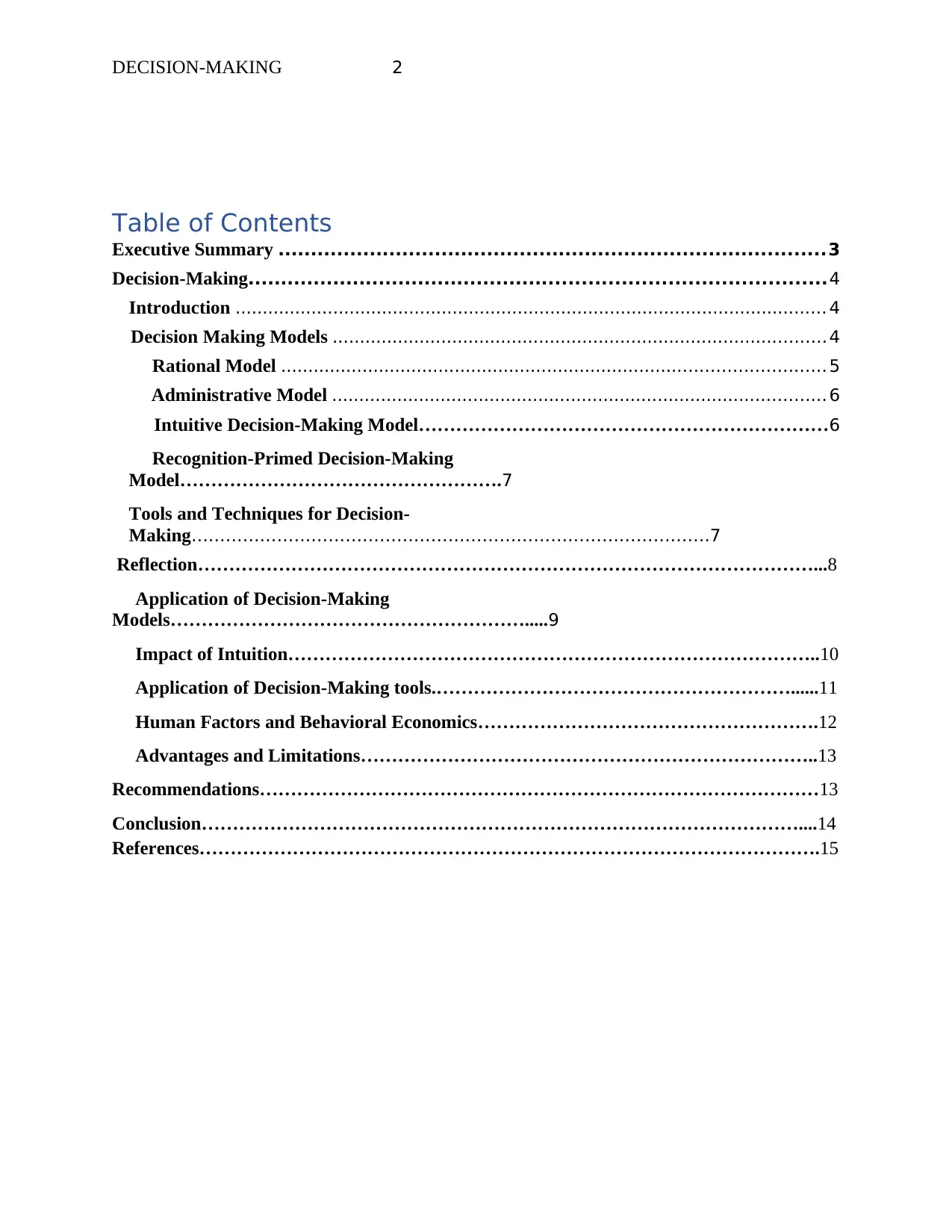
DECISION-MAKING 2
Table of Contents
Executive Summary ....................................................................................3
Decision-Making........................................................................................4
Introduction ............................................................................................................. 4
Decision Making Models ........................................................................................... 4
Rational Model .................................................................................................... 5
Administrative Model ........................................................................................... 6
Intuitive Decision-Making Model…………………………………………………………6
Recognition-Primed Decision-Making
Model…………………………………………….7
Tools and Techniques for Decision-
Making……………………………………………………………………………….7
Reflection………………………………………………………………………………………...8
Application of Decision-Making
Models………………………………………………….....9
Impact of Intuition…………………………………………………………………………..10
Application of Decision-Making tools.…………………………………………………......11
Human Factors and Behavioral Economics……………………………………………….12
Advantages and Limitations………………………………………………………………..13
Recommendations………………………………………………………………………………13
Conclusion……………………………………………………………………………………....14
References……………………………………………………………………………………….15
Table of Contents
Executive Summary ....................................................................................3
Decision-Making........................................................................................4
Introduction ............................................................................................................. 4
Decision Making Models ........................................................................................... 4
Rational Model .................................................................................................... 5
Administrative Model ........................................................................................... 6
Intuitive Decision-Making Model…………………………………………………………6
Recognition-Primed Decision-Making
Model…………………………………………….7
Tools and Techniques for Decision-
Making……………………………………………………………………………….7
Reflection………………………………………………………………………………………...8
Application of Decision-Making
Models………………………………………………….....9
Impact of Intuition…………………………………………………………………………..10
Application of Decision-Making tools.…………………………………………………......11
Human Factors and Behavioral Economics……………………………………………….12
Advantages and Limitations………………………………………………………………..13
Recommendations………………………………………………………………………………13
Conclusion……………………………………………………………………………………....14
References……………………………………………………………………………………….15

DECISION-MAKING 3
⊘ This is a preview!⊘
Do you want full access?
Subscribe today to unlock all pages.

Trusted by 1+ million students worldwide
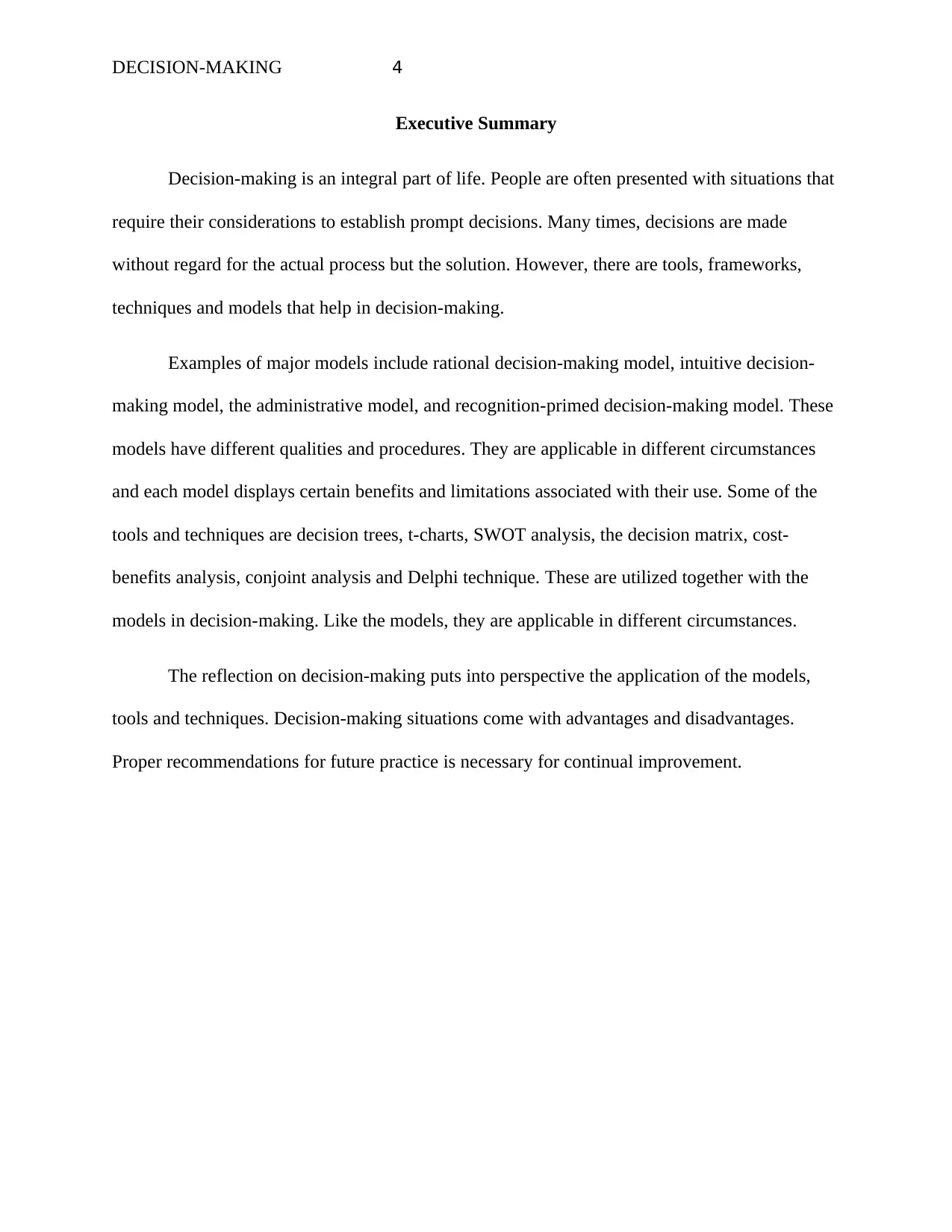
DECISION-MAKING 4
Executive Summary
Decision-making is an integral part of life. People are often presented with situations that
require their considerations to establish prompt decisions. Many times, decisions are made
without regard for the actual process but the solution. However, there are tools, frameworks,
techniques and models that help in decision-making.
Examples of major models include rational decision-making model, intuitive decision-
making model, the administrative model, and recognition-primed decision-making model. These
models have different qualities and procedures. They are applicable in different circumstances
and each model displays certain benefits and limitations associated with their use. Some of the
tools and techniques are decision trees, t-charts, SWOT analysis, the decision matrix, cost-
benefits analysis, conjoint analysis and Delphi technique. These are utilized together with the
models in decision-making. Like the models, they are applicable in different circumstances.
The reflection on decision-making puts into perspective the application of the models,
tools and techniques. Decision-making situations come with advantages and disadvantages.
Proper recommendations for future practice is necessary for continual improvement.
Executive Summary
Decision-making is an integral part of life. People are often presented with situations that
require their considerations to establish prompt decisions. Many times, decisions are made
without regard for the actual process but the solution. However, there are tools, frameworks,
techniques and models that help in decision-making.
Examples of major models include rational decision-making model, intuitive decision-
making model, the administrative model, and recognition-primed decision-making model. These
models have different qualities and procedures. They are applicable in different circumstances
and each model displays certain benefits and limitations associated with their use. Some of the
tools and techniques are decision trees, t-charts, SWOT analysis, the decision matrix, cost-
benefits analysis, conjoint analysis and Delphi technique. These are utilized together with the
models in decision-making. Like the models, they are applicable in different circumstances.
The reflection on decision-making puts into perspective the application of the models,
tools and techniques. Decision-making situations come with advantages and disadvantages.
Proper recommendations for future practice is necessary for continual improvement.
Paraphrase This Document
Need a fresh take? Get an instant paraphrase of this document with our AI Paraphraser

DECISION-MAKING 5
Decision-Making
Introduction
Decision making is a vital quality that is necessary in our day to day lives. Decision
making in many case is done without regard for how it should be done. However, there are
particular devices that are utilized in informing better decision making (Klein, 2008). In general,
decision making is the process of identification of a choice. This choice is made based on
information that is gathered and assessment of alternative options (Zsambok & Klein, 2014).
Effective decision-making can be achieved through following the steps that comprise the
process. One must be able to define the nature of the decision he or she intends to make after
recognition of the need to make that decision (Klein, 2008). The relevant information should be
collected. This may be through internal assessment or use of external sources. This provides the
needed knowledge to make an informed decision. This is followed by identification of the
possible alternatives to the decision. A decision maker should weigh the evidence obtained and
make the best choice out of the possibilities. After making the decision, it can be reviewed and
the consequences assessed (Rardin & Rardin, 2016; Hastie & Dawes, 2010; UMass, 2018).
The following reflection discusses the models, tools and techniques and their importance
in decision making. Different styles of decision making are also compared and contrasted. These
styles use reason and logic in varying capacities with application of intuition and instinct (Zionts,
2012).
Decision-Making Models
Decision-Making
Introduction
Decision making is a vital quality that is necessary in our day to day lives. Decision
making in many case is done without regard for how it should be done. However, there are
particular devices that are utilized in informing better decision making (Klein, 2008). In general,
decision making is the process of identification of a choice. This choice is made based on
information that is gathered and assessment of alternative options (Zsambok & Klein, 2014).
Effective decision-making can be achieved through following the steps that comprise the
process. One must be able to define the nature of the decision he or she intends to make after
recognition of the need to make that decision (Klein, 2008). The relevant information should be
collected. This may be through internal assessment or use of external sources. This provides the
needed knowledge to make an informed decision. This is followed by identification of the
possible alternatives to the decision. A decision maker should weigh the evidence obtained and
make the best choice out of the possibilities. After making the decision, it can be reviewed and
the consequences assessed (Rardin & Rardin, 2016; Hastie & Dawes, 2010; UMass, 2018).
The following reflection discusses the models, tools and techniques and their importance
in decision making. Different styles of decision making are also compared and contrasted. These
styles use reason and logic in varying capacities with application of intuition and instinct (Zionts,
2012).
Decision-Making Models
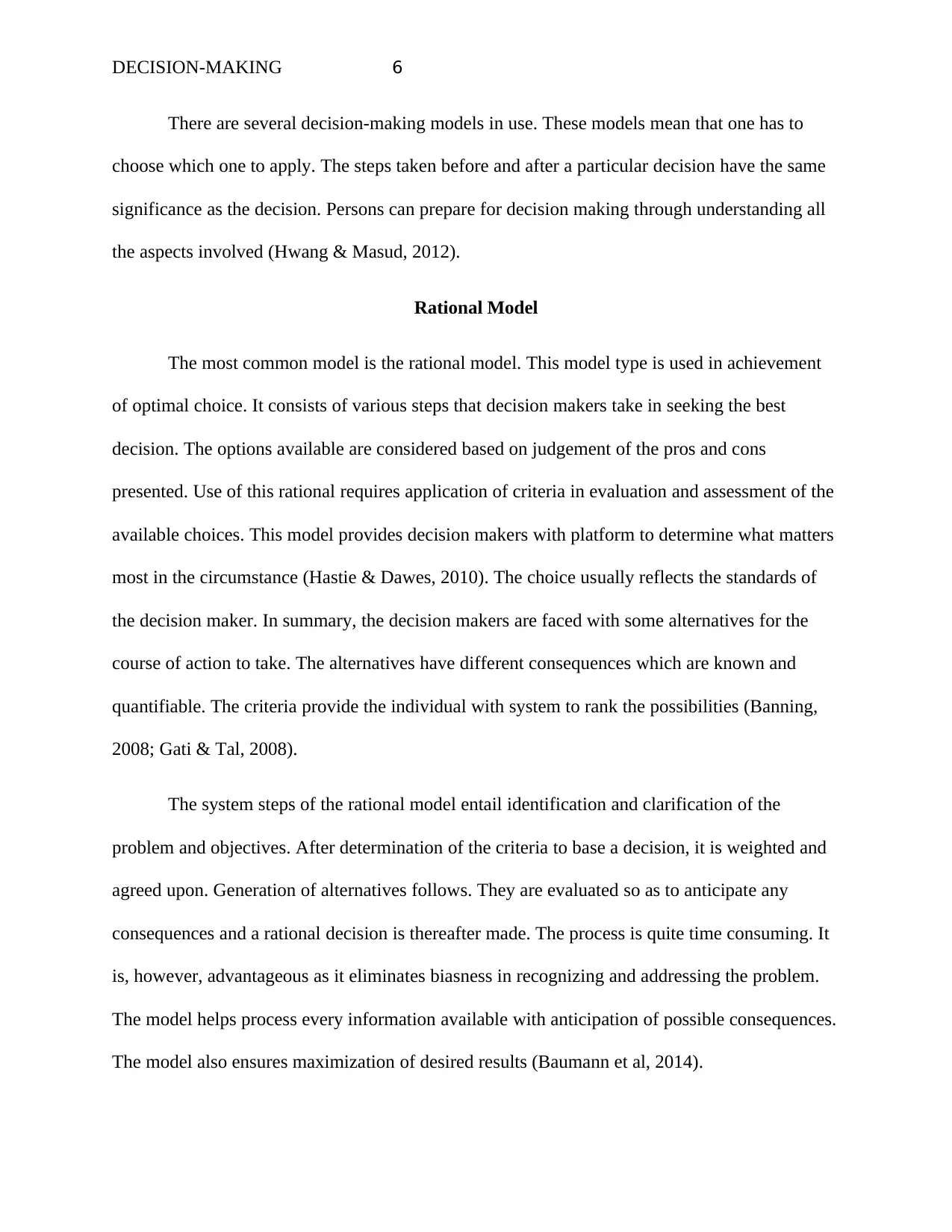
DECISION-MAKING 6
There are several decision-making models in use. These models mean that one has to
choose which one to apply. The steps taken before and after a particular decision have the same
significance as the decision. Persons can prepare for decision making through understanding all
the aspects involved (Hwang & Masud, 2012).
Rational Model
The most common model is the rational model. This model type is used in achievement
of optimal choice. It consists of various steps that decision makers take in seeking the best
decision. The options available are considered based on judgement of the pros and cons
presented. Use of this rational requires application of criteria in evaluation and assessment of the
available choices. This model provides decision makers with platform to determine what matters
most in the circumstance (Hastie & Dawes, 2010). The choice usually reflects the standards of
the decision maker. In summary, the decision makers are faced with some alternatives for the
course of action to take. The alternatives have different consequences which are known and
quantifiable. The criteria provide the individual with system to rank the possibilities (Banning,
2008; Gati & Tal, 2008).
The system steps of the rational model entail identification and clarification of the
problem and objectives. After determination of the criteria to base a decision, it is weighted and
agreed upon. Generation of alternatives follows. They are evaluated so as to anticipate any
consequences and a rational decision is thereafter made. The process is quite time consuming. It
is, however, advantageous as it eliminates biasness in recognizing and addressing the problem.
The model helps process every information available with anticipation of possible consequences.
The model also ensures maximization of desired results (Baumann et al, 2014).
There are several decision-making models in use. These models mean that one has to
choose which one to apply. The steps taken before and after a particular decision have the same
significance as the decision. Persons can prepare for decision making through understanding all
the aspects involved (Hwang & Masud, 2012).
Rational Model
The most common model is the rational model. This model type is used in achievement
of optimal choice. It consists of various steps that decision makers take in seeking the best
decision. The options available are considered based on judgement of the pros and cons
presented. Use of this rational requires application of criteria in evaluation and assessment of the
available choices. This model provides decision makers with platform to determine what matters
most in the circumstance (Hastie & Dawes, 2010). The choice usually reflects the standards of
the decision maker. In summary, the decision makers are faced with some alternatives for the
course of action to take. The alternatives have different consequences which are known and
quantifiable. The criteria provide the individual with system to rank the possibilities (Banning,
2008; Gati & Tal, 2008).
The system steps of the rational model entail identification and clarification of the
problem and objectives. After determination of the criteria to base a decision, it is weighted and
agreed upon. Generation of alternatives follows. They are evaluated so as to anticipate any
consequences and a rational decision is thereafter made. The process is quite time consuming. It
is, however, advantageous as it eliminates biasness in recognizing and addressing the problem.
The model helps process every information available with anticipation of possible consequences.
The model also ensures maximization of desired results (Baumann et al, 2014).
⊘ This is a preview!⊘
Do you want full access?
Subscribe today to unlock all pages.

Trusted by 1+ million students worldwide
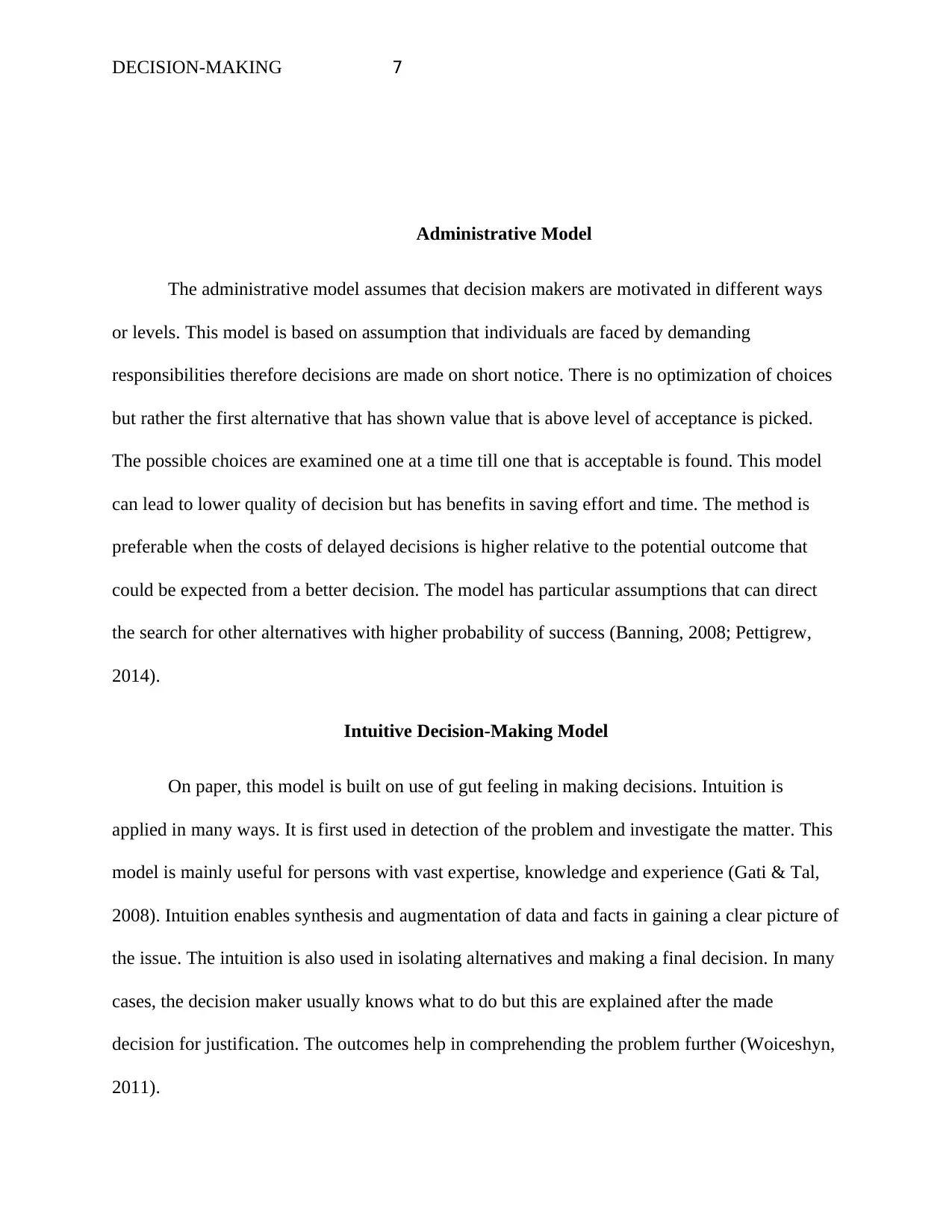
DECISION-MAKING 7
Administrative Model
The administrative model assumes that decision makers are motivated in different ways
or levels. This model is based on assumption that individuals are faced by demanding
responsibilities therefore decisions are made on short notice. There is no optimization of choices
but rather the first alternative that has shown value that is above level of acceptance is picked.
The possible choices are examined one at a time till one that is acceptable is found. This model
can lead to lower quality of decision but has benefits in saving effort and time. The method is
preferable when the costs of delayed decisions is higher relative to the potential outcome that
could be expected from a better decision. The model has particular assumptions that can direct
the search for other alternatives with higher probability of success (Banning, 2008; Pettigrew,
2014).
Intuitive Decision-Making Model
On paper, this model is built on use of gut feeling in making decisions. Intuition is
applied in many ways. It is first used in detection of the problem and investigate the matter. This
model is mainly useful for persons with vast expertise, knowledge and experience (Gati & Tal,
2008). Intuition enables synthesis and augmentation of data and facts in gaining a clear picture of
the issue. The intuition is also used in isolating alternatives and making a final decision. In many
cases, the decision maker usually knows what to do but this are explained after the made
decision for justification. The outcomes help in comprehending the problem further (Woiceshyn,
2011).
Administrative Model
The administrative model assumes that decision makers are motivated in different ways
or levels. This model is based on assumption that individuals are faced by demanding
responsibilities therefore decisions are made on short notice. There is no optimization of choices
but rather the first alternative that has shown value that is above level of acceptance is picked.
The possible choices are examined one at a time till one that is acceptable is found. This model
can lead to lower quality of decision but has benefits in saving effort and time. The method is
preferable when the costs of delayed decisions is higher relative to the potential outcome that
could be expected from a better decision. The model has particular assumptions that can direct
the search for other alternatives with higher probability of success (Banning, 2008; Pettigrew,
2014).
Intuitive Decision-Making Model
On paper, this model is built on use of gut feeling in making decisions. Intuition is
applied in many ways. It is first used in detection of the problem and investigate the matter. This
model is mainly useful for persons with vast expertise, knowledge and experience (Gati & Tal,
2008). Intuition enables synthesis and augmentation of data and facts in gaining a clear picture of
the issue. The intuition is also used in isolating alternatives and making a final decision. In many
cases, the decision maker usually knows what to do but this are explained after the made
decision for justification. The outcomes help in comprehending the problem further (Woiceshyn,
2011).
Paraphrase This Document
Need a fresh take? Get an instant paraphrase of this document with our AI Paraphraser
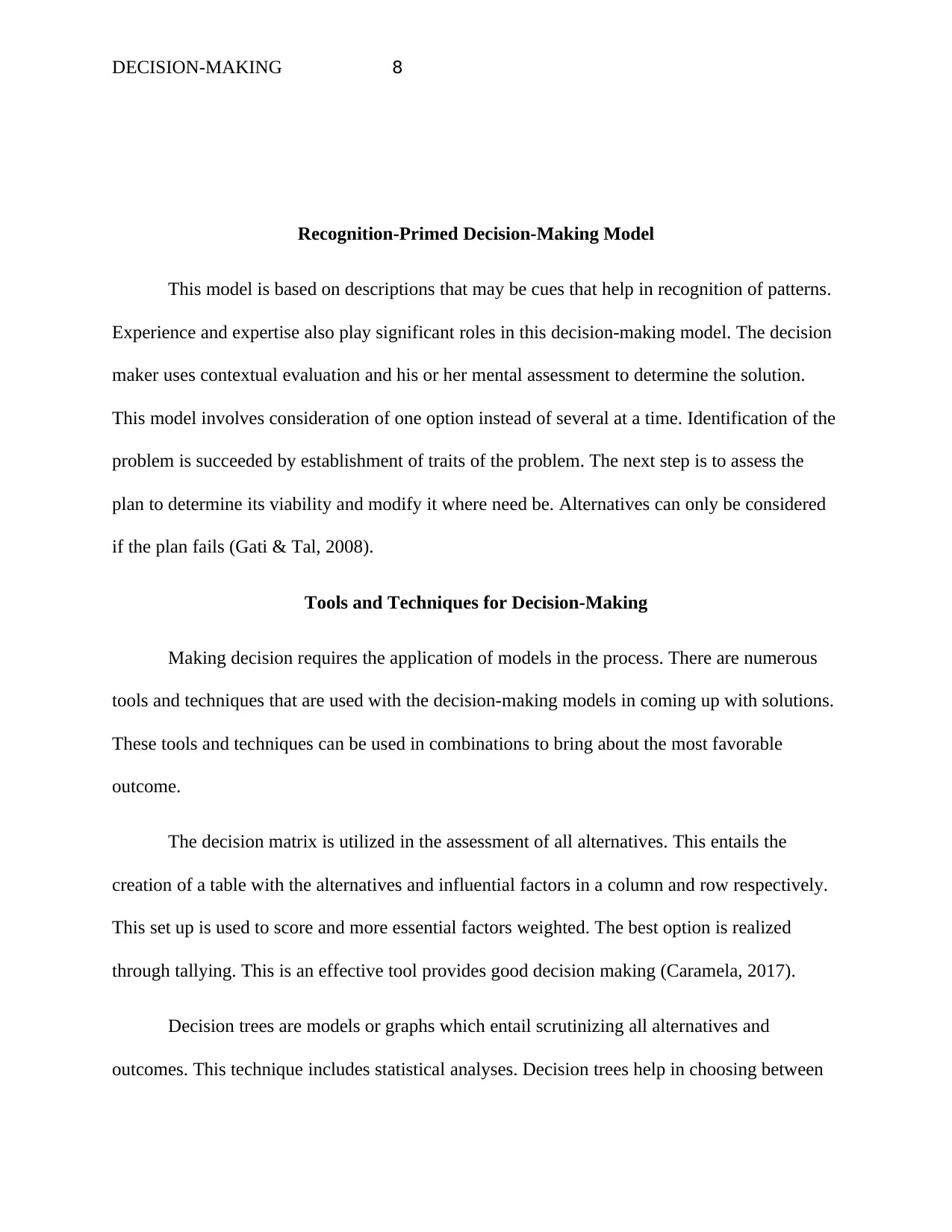
DECISION-MAKING 8
Recognition-Primed Decision-Making Model
This model is based on descriptions that may be cues that help in recognition of patterns.
Experience and expertise also play significant roles in this decision-making model. The decision
maker uses contextual evaluation and his or her mental assessment to determine the solution.
This model involves consideration of one option instead of several at a time. Identification of the
problem is succeeded by establishment of traits of the problem. The next step is to assess the
plan to determine its viability and modify it where need be. Alternatives can only be considered
if the plan fails (Gati & Tal, 2008).
Tools and Techniques for Decision-Making
Making decision requires the application of models in the process. There are numerous
tools and techniques that are used with the decision-making models in coming up with solutions.
These tools and techniques can be used in combinations to bring about the most favorable
outcome.
The decision matrix is utilized in the assessment of all alternatives. This entails the
creation of a table with the alternatives and influential factors in a column and row respectively.
This set up is used to score and more essential factors weighted. The best option is realized
through tallying. This is an effective tool provides good decision making (Caramela, 2017).
Decision trees are models or graphs which entail scrutinizing all alternatives and
outcomes. This technique includes statistical analyses. Decision trees help in choosing between
Recognition-Primed Decision-Making Model
This model is based on descriptions that may be cues that help in recognition of patterns.
Experience and expertise also play significant roles in this decision-making model. The decision
maker uses contextual evaluation and his or her mental assessment to determine the solution.
This model involves consideration of one option instead of several at a time. Identification of the
problem is succeeded by establishment of traits of the problem. The next step is to assess the
plan to determine its viability and modify it where need be. Alternatives can only be considered
if the plan fails (Gati & Tal, 2008).
Tools and Techniques for Decision-Making
Making decision requires the application of models in the process. There are numerous
tools and techniques that are used with the decision-making models in coming up with solutions.
These tools and techniques can be used in combinations to bring about the most favorable
outcome.
The decision matrix is utilized in the assessment of all alternatives. This entails the
creation of a table with the alternatives and influential factors in a column and row respectively.
This set up is used to score and more essential factors weighted. The best option is realized
through tallying. This is an effective tool provides good decision making (Caramela, 2017).
Decision trees are models or graphs which entail scrutinizing all alternatives and
outcomes. This technique includes statistical analyses. Decision trees help in choosing between

DECISION-MAKING 9
multiple options. The tree diagram has a representation of different decisions to be made, the
flow in structure and how they may relate to each other (Tzeng, & Huang, 2011).
The Delphi technique is used in the determination of the potential of an event and the
outcomes. This method uses written feedback from questionnaires. The questions are based on
each other. The decision is attained when consensus is reached according to the responses of
individuals (Rowe & Wright, 2011).
Cost-benefit analysis is mainly used on financial grounds. All alternatives are examined
in order to reach an economically reasonable decision. Other techniques include t-charts used in
weighing the positives and negatives of an alternative. SWOT analysis helps in evaluation of
strengths, weaknesses, opportunities, and threats. Conjoint analysis is used in relation to
decisions involving consumer preferences (Chai, Liu & Ngai, 2013).
Reflection
Making a career change is coming at a time when many variables and factors are in play.
The decision on whether to make a different career move had been a long time coming. There are
many reasons for these thoughts, but the most recent circumstance which has led to more
urgency in the matter is the relocation of my family to another city miles away. In previous
occasions I had considerations of switching jobs, there was no sense of hurry. I would say not
having my family close to me as has always been the case brought the need to make a decision
on my career.
The decision has been majorly influenced by internal factors. However, the conception of
the decision has taken some planning. There are other factors that led to the development of the
idea. The factors that were involved before family relocation came into the picture included
multiple options. The tree diagram has a representation of different decisions to be made, the
flow in structure and how they may relate to each other (Tzeng, & Huang, 2011).
The Delphi technique is used in the determination of the potential of an event and the
outcomes. This method uses written feedback from questionnaires. The questions are based on
each other. The decision is attained when consensus is reached according to the responses of
individuals (Rowe & Wright, 2011).
Cost-benefit analysis is mainly used on financial grounds. All alternatives are examined
in order to reach an economically reasonable decision. Other techniques include t-charts used in
weighing the positives and negatives of an alternative. SWOT analysis helps in evaluation of
strengths, weaknesses, opportunities, and threats. Conjoint analysis is used in relation to
decisions involving consumer preferences (Chai, Liu & Ngai, 2013).
Reflection
Making a career change is coming at a time when many variables and factors are in play.
The decision on whether to make a different career move had been a long time coming. There are
many reasons for these thoughts, but the most recent circumstance which has led to more
urgency in the matter is the relocation of my family to another city miles away. In previous
occasions I had considerations of switching jobs, there was no sense of hurry. I would say not
having my family close to me as has always been the case brought the need to make a decision
on my career.
The decision has been majorly influenced by internal factors. However, the conception of
the decision has taken some planning. There are other factors that led to the development of the
idea. The factors that were involved before family relocation came into the picture included
⊘ This is a preview!⊘
Do you want full access?
Subscribe today to unlock all pages.

Trusted by 1+ million students worldwide
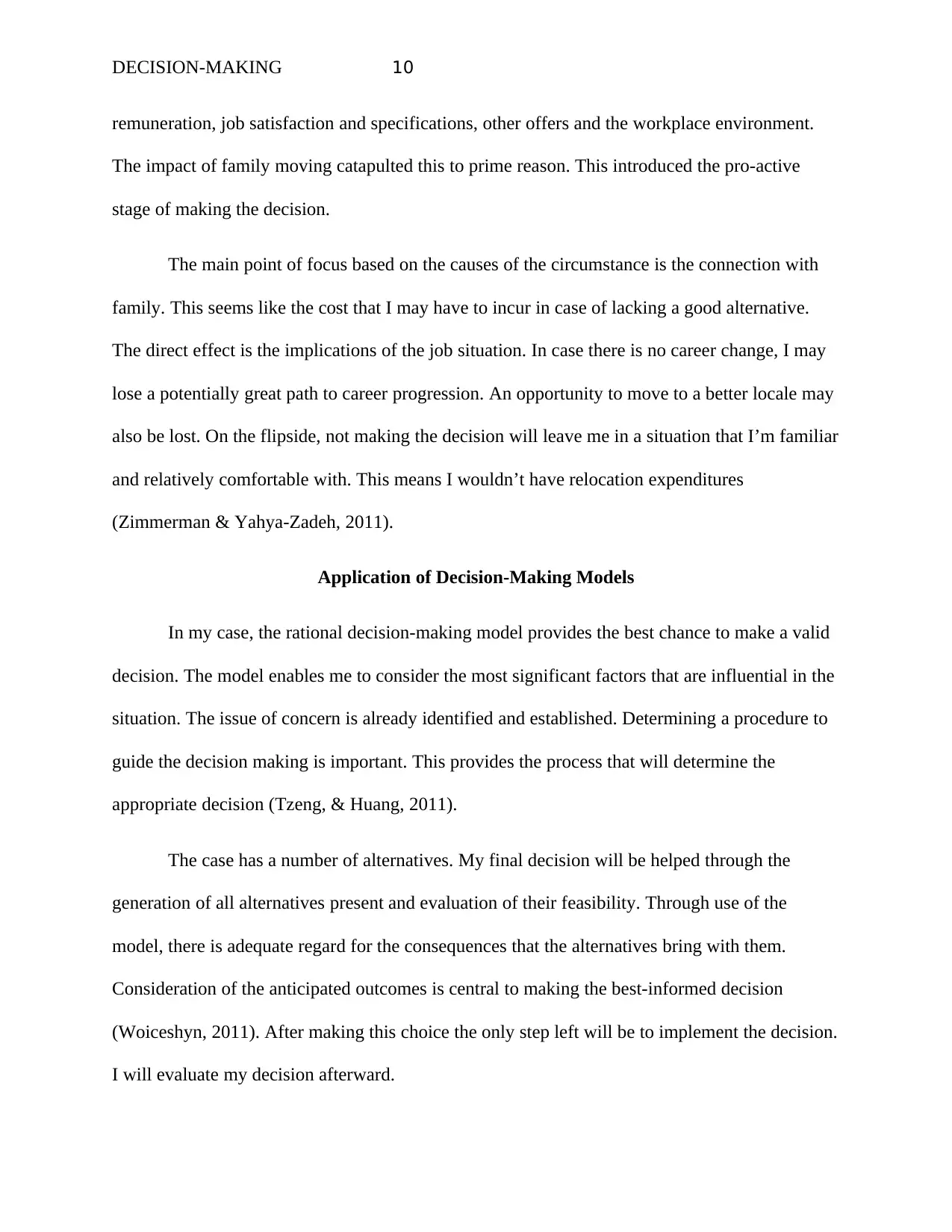
DECISION-MAKING 10
remuneration, job satisfaction and specifications, other offers and the workplace environment.
The impact of family moving catapulted this to prime reason. This introduced the pro-active
stage of making the decision.
The main point of focus based on the causes of the circumstance is the connection with
family. This seems like the cost that I may have to incur in case of lacking a good alternative.
The direct effect is the implications of the job situation. In case there is no career change, I may
lose a potentially great path to career progression. An opportunity to move to a better locale may
also be lost. On the flipside, not making the decision will leave me in a situation that I’m familiar
and relatively comfortable with. This means I wouldn’t have relocation expenditures
(Zimmerman & Yahya-Zadeh, 2011).
Application of Decision-Making Models
In my case, the rational decision-making model provides the best chance to make a valid
decision. The model enables me to consider the most significant factors that are influential in the
situation. The issue of concern is already identified and established. Determining a procedure to
guide the decision making is important. This provides the process that will determine the
appropriate decision (Tzeng, & Huang, 2011).
The case has a number of alternatives. My final decision will be helped through the
generation of all alternatives present and evaluation of their feasibility. Through use of the
model, there is adequate regard for the consequences that the alternatives bring with them.
Consideration of the anticipated outcomes is central to making the best-informed decision
(Woiceshyn, 2011). After making this choice the only step left will be to implement the decision.
I will evaluate my decision afterward.
remuneration, job satisfaction and specifications, other offers and the workplace environment.
The impact of family moving catapulted this to prime reason. This introduced the pro-active
stage of making the decision.
The main point of focus based on the causes of the circumstance is the connection with
family. This seems like the cost that I may have to incur in case of lacking a good alternative.
The direct effect is the implications of the job situation. In case there is no career change, I may
lose a potentially great path to career progression. An opportunity to move to a better locale may
also be lost. On the flipside, not making the decision will leave me in a situation that I’m familiar
and relatively comfortable with. This means I wouldn’t have relocation expenditures
(Zimmerman & Yahya-Zadeh, 2011).
Application of Decision-Making Models
In my case, the rational decision-making model provides the best chance to make a valid
decision. The model enables me to consider the most significant factors that are influential in the
situation. The issue of concern is already identified and established. Determining a procedure to
guide the decision making is important. This provides the process that will determine the
appropriate decision (Tzeng, & Huang, 2011).
The case has a number of alternatives. My final decision will be helped through the
generation of all alternatives present and evaluation of their feasibility. Through use of the
model, there is adequate regard for the consequences that the alternatives bring with them.
Consideration of the anticipated outcomes is central to making the best-informed decision
(Woiceshyn, 2011). After making this choice the only step left will be to implement the decision.
I will evaluate my decision afterward.
Paraphrase This Document
Need a fresh take? Get an instant paraphrase of this document with our AI Paraphraser
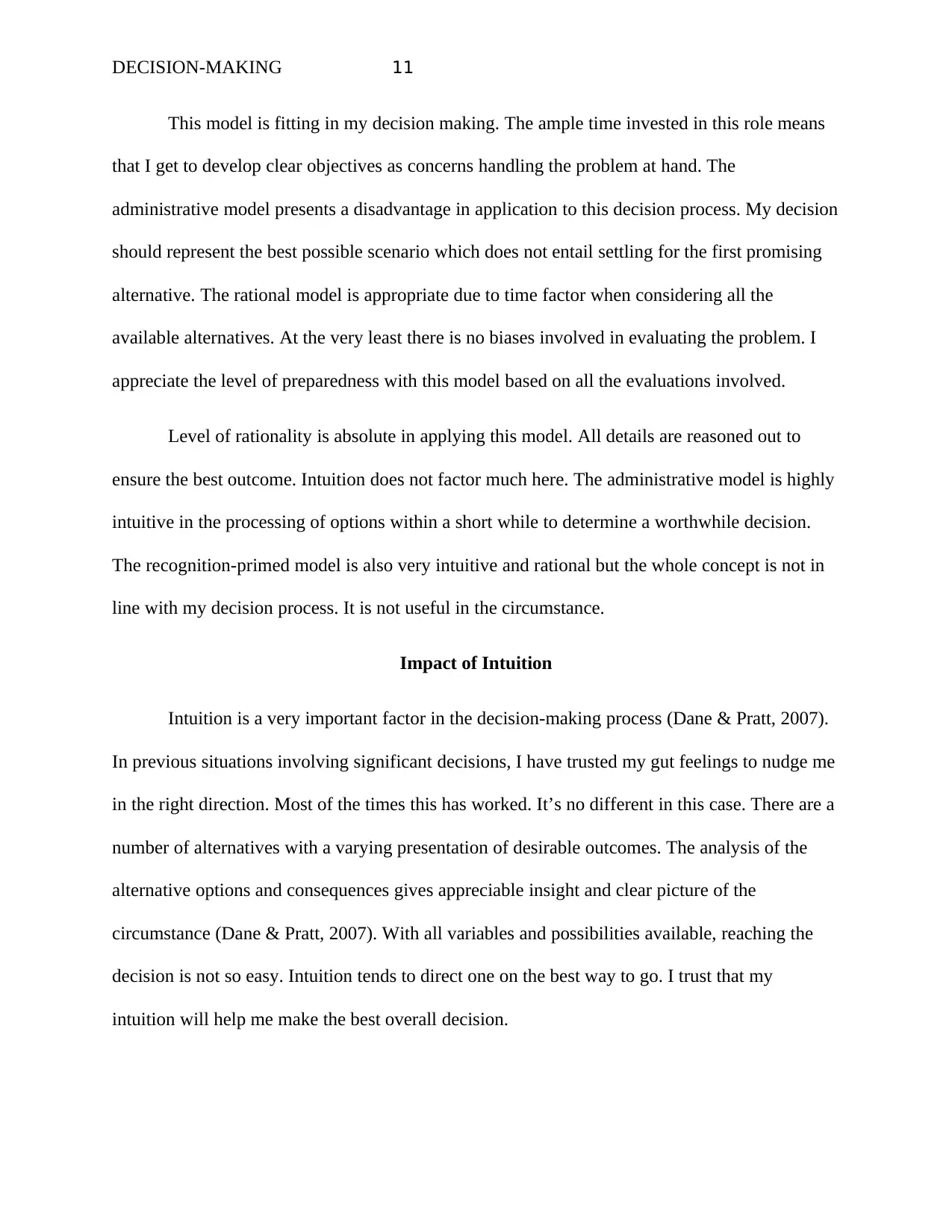
DECISION-MAKING 11
This model is fitting in my decision making. The ample time invested in this role means
that I get to develop clear objectives as concerns handling the problem at hand. The
administrative model presents a disadvantage in application to this decision process. My decision
should represent the best possible scenario which does not entail settling for the first promising
alternative. The rational model is appropriate due to time factor when considering all the
available alternatives. At the very least there is no biases involved in evaluating the problem. I
appreciate the level of preparedness with this model based on all the evaluations involved.
Level of rationality is absolute in applying this model. All details are reasoned out to
ensure the best outcome. Intuition does not factor much here. The administrative model is highly
intuitive in the processing of options within a short while to determine a worthwhile decision.
The recognition-primed model is also very intuitive and rational but the whole concept is not in
line with my decision process. It is not useful in the circumstance.
Impact of Intuition
Intuition is a very important factor in the decision-making process (Dane & Pratt, 2007).
In previous situations involving significant decisions, I have trusted my gut feelings to nudge me
in the right direction. Most of the times this has worked. It’s no different in this case. There are a
number of alternatives with a varying presentation of desirable outcomes. The analysis of the
alternative options and consequences gives appreciable insight and clear picture of the
circumstance (Dane & Pratt, 2007). With all variables and possibilities available, reaching the
decision is not so easy. Intuition tends to direct one on the best way to go. I trust that my
intuition will help me make the best overall decision.
This model is fitting in my decision making. The ample time invested in this role means
that I get to develop clear objectives as concerns handling the problem at hand. The
administrative model presents a disadvantage in application to this decision process. My decision
should represent the best possible scenario which does not entail settling for the first promising
alternative. The rational model is appropriate due to time factor when considering all the
available alternatives. At the very least there is no biases involved in evaluating the problem. I
appreciate the level of preparedness with this model based on all the evaluations involved.
Level of rationality is absolute in applying this model. All details are reasoned out to
ensure the best outcome. Intuition does not factor much here. The administrative model is highly
intuitive in the processing of options within a short while to determine a worthwhile decision.
The recognition-primed model is also very intuitive and rational but the whole concept is not in
line with my decision process. It is not useful in the circumstance.
Impact of Intuition
Intuition is a very important factor in the decision-making process (Dane & Pratt, 2007).
In previous situations involving significant decisions, I have trusted my gut feelings to nudge me
in the right direction. Most of the times this has worked. It’s no different in this case. There are a
number of alternatives with a varying presentation of desirable outcomes. The analysis of the
alternative options and consequences gives appreciable insight and clear picture of the
circumstance (Dane & Pratt, 2007). With all variables and possibilities available, reaching the
decision is not so easy. Intuition tends to direct one on the best way to go. I trust that my
intuition will help me make the best overall decision.
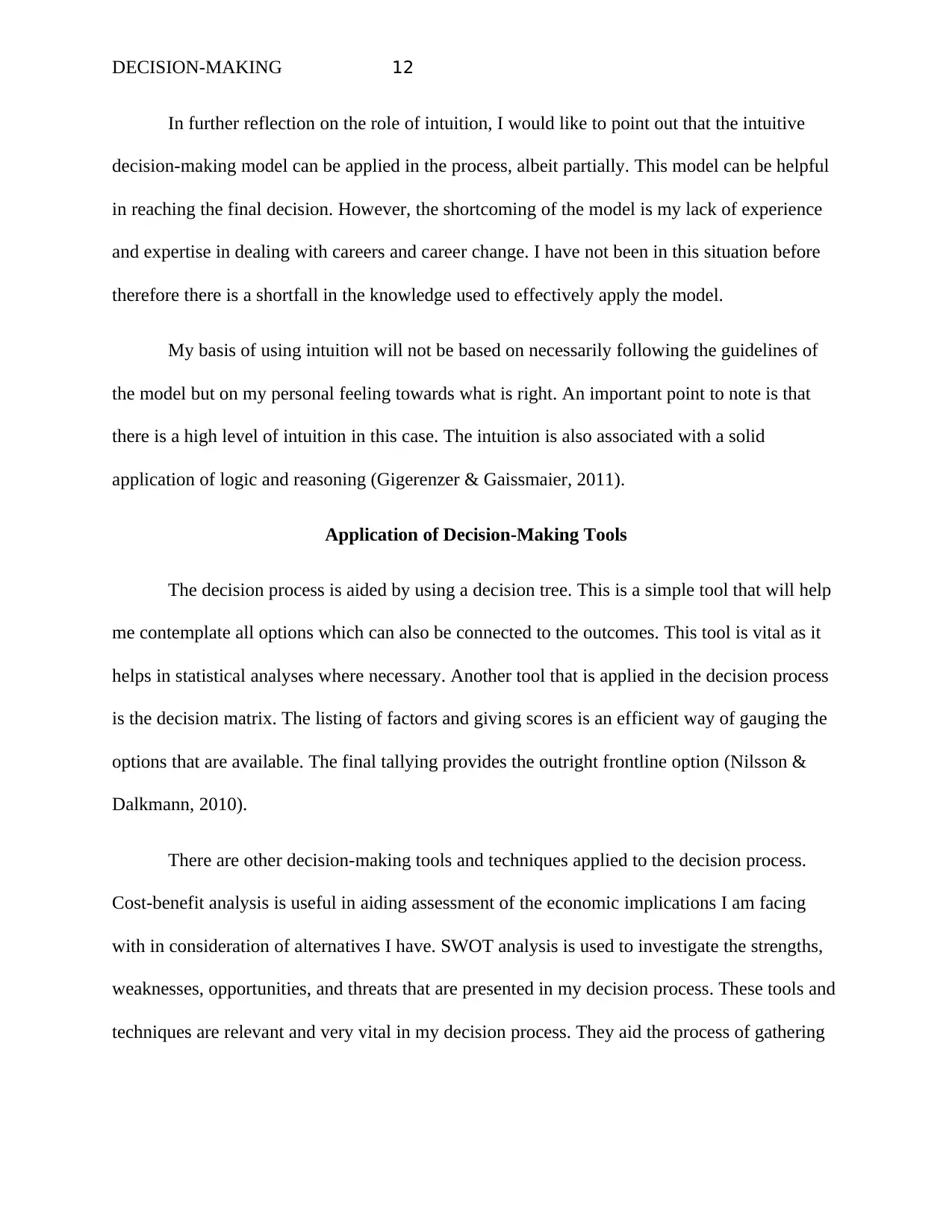
DECISION-MAKING 12
In further reflection on the role of intuition, I would like to point out that the intuitive
decision-making model can be applied in the process, albeit partially. This model can be helpful
in reaching the final decision. However, the shortcoming of the model is my lack of experience
and expertise in dealing with careers and career change. I have not been in this situation before
therefore there is a shortfall in the knowledge used to effectively apply the model.
My basis of using intuition will not be based on necessarily following the guidelines of
the model but on my personal feeling towards what is right. An important point to note is that
there is a high level of intuition in this case. The intuition is also associated with a solid
application of logic and reasoning (Gigerenzer & Gaissmaier, 2011).
Application of Decision-Making Tools
The decision process is aided by using a decision tree. This is a simple tool that will help
me contemplate all options which can also be connected to the outcomes. This tool is vital as it
helps in statistical analyses where necessary. Another tool that is applied in the decision process
is the decision matrix. The listing of factors and giving scores is an efficient way of gauging the
options that are available. The final tallying provides the outright frontline option (Nilsson &
Dalkmann, 2010).
There are other decision-making tools and techniques applied to the decision process.
Cost-benefit analysis is useful in aiding assessment of the economic implications I am facing
with in consideration of alternatives I have. SWOT analysis is used to investigate the strengths,
weaknesses, opportunities, and threats that are presented in my decision process. These tools and
techniques are relevant and very vital in my decision process. They aid the process of gathering
In further reflection on the role of intuition, I would like to point out that the intuitive
decision-making model can be applied in the process, albeit partially. This model can be helpful
in reaching the final decision. However, the shortcoming of the model is my lack of experience
and expertise in dealing with careers and career change. I have not been in this situation before
therefore there is a shortfall in the knowledge used to effectively apply the model.
My basis of using intuition will not be based on necessarily following the guidelines of
the model but on my personal feeling towards what is right. An important point to note is that
there is a high level of intuition in this case. The intuition is also associated with a solid
application of logic and reasoning (Gigerenzer & Gaissmaier, 2011).
Application of Decision-Making Tools
The decision process is aided by using a decision tree. This is a simple tool that will help
me contemplate all options which can also be connected to the outcomes. This tool is vital as it
helps in statistical analyses where necessary. Another tool that is applied in the decision process
is the decision matrix. The listing of factors and giving scores is an efficient way of gauging the
options that are available. The final tallying provides the outright frontline option (Nilsson &
Dalkmann, 2010).
There are other decision-making tools and techniques applied to the decision process.
Cost-benefit analysis is useful in aiding assessment of the economic implications I am facing
with in consideration of alternatives I have. SWOT analysis is used to investigate the strengths,
weaknesses, opportunities, and threats that are presented in my decision process. These tools and
techniques are relevant and very vital in my decision process. They aid the process of gathering
⊘ This is a preview!⊘
Do you want full access?
Subscribe today to unlock all pages.

Trusted by 1+ million students worldwide
1 out of 18
Related Documents
Your All-in-One AI-Powered Toolkit for Academic Success.
+13062052269
info@desklib.com
Available 24*7 on WhatsApp / Email
![[object Object]](/_next/static/media/star-bottom.7253800d.svg)
Unlock your academic potential
Copyright © 2020–2025 A2Z Services. All Rights Reserved. Developed and managed by ZUCOL.





